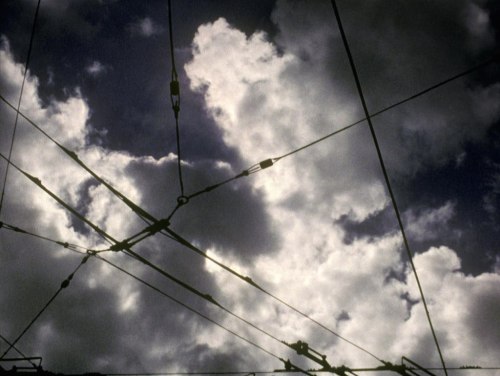
Nathaniel Dorsky, still from Song and Solitude (2005–06)
The films of Nathaniel Dorsky and Jerome Hiler are silent, brief, and sagely meandering – luminous contemplations of life, film, and the intimacies between the two. They also inspire a curious set of ironies. They are the sorts of films that – now, in the days of hegemonic digital movie making and screens, the spoils and joys of Netflix – you wish you could hold and return to, watch and rewatch, alone somewhere in the illuminated dark. Dorsky, who has spoken frequently of John Ashbery’s influence on his filmmaking, described an epiphany of reading Ashbery’s poetry – “very slowly, one word at a time” – and longing to reveal that experience and resonance in film.
So why not luxuriate in Dorsky’s, and Hiler’s, work the way Dorsky has done with Ashbury?
Dorsky and Hiler, currently enjoying a remarkable retrospective at this year’s New York Film Festival (NYFF), have worked and shared their lives together since the early 1960s. They are enchanted filmmakers at the terminal edge of film, making and showing 16mm movies beyond the last days of Kodachrome and other phased-out film stock – into a time when even film festivals themselves, as Dorsky noted in one of his NYFF Q&As, can screen few true films. It’s a great, almost regressive pleasure, then, to see so many of their works at one time, in one place. Dorsky himself spoke of his delight and surprise at seeing his older films again, and projected so beautifully in the Francesca Beale Theater, almost wishing he could once more create in that way, with that same feeling and atmosphere of 10 and 20 years past. For some of the films screened during the retrospective, it has been a decade or more since he last saw them.
These films, above all, exist as film: something physical, with limitations and potential, that can be manipulated, but only so far, can be seen, but only at some expense. At screenings of his films, Hiler projects his camera originals, and even used to make edits to them. With each further cut or adjustment, each battering screening and passing year, his films degrade and take on the qualities of a palimpsest. Not as prolific as Dorsky (the two occasionally work together but have distinct careers and release pieces under their own names), Hiler makes quiet, aging films that seem to grow more beautiful and lustrous with time. His work is rarified, building up luminous layers through in-camera superimposition: he films and rolls the film back, shooting again over the same stretch, often more than three times. Also a stained-glass artist, he works with a quiet magnanimity, a trust, but also a knowledge of how many layers the film and its footage can accommodate, what he calls filming “with courtesy.” Words of Mercury (2013), for instance, lovingly explores the capacity of his Ektachrome 7285 film to hold and layer multiple colors and images, reveling in fluorescence: a dark pastoral scene streaked with neon light, a bundle of flower brought up to blazing lime. Hiler rhapsodically pursues the potential of film and the world to change, to respond to opportunity and chance and uncover the “possibility of transmutation.”
Dorsky’s Pneuma (1977-83) and Alaya (1976-87) also explore this overlap, or perhaps more accurately the gap, between film and the world, the space between their extremes that connects them. Both works take the “grain” as their subject: film grain in Pneuma and grains of sand in Alaya. Edited from expired and unexposed film stock, Pneuma features a scene where, rephotographing from different distances and approaches, Dorsky finds the grains swelling and contracting, covering the distance between them and then opening it up again. While not intended as a pair (they were split during their NYFF screening, separated by the four-image, camera-bug-eyed 17 Reasons Why), Pneuma and Alaya are nevertheless cousinly works, observing in hypnotic, often strikingly similar ways grains in film and out in the world.
For these two visionaries, film and its emulsion – the stuff that captures and gives the images color – can be expanded, even humanized. Dorsky spoke at one of the NYFF screenings of wanting the film to yearn for the light, of scenes “ripening,” ready for a cut. In Avraham (2014), one of his newest works, he flits through F- stops, tracking the film through the darkest edge of it emulsion to its upper radiance. There’s light and darkness in the reel, but also mood, energy, invitation. Many scenes in his later works hover on the rim of recognition, not quite perceptible, because knowing would somehow be less. Dorsky and his camera delight in the texture of curtains and jackets and the way light look splashed upon or through them; they pause and peer through a web of twisting tree limbs, or stare, entranced, at a lens flair or motes of dust; they alight, out- of-focus, on a clump of grass, finding that its blades appear as the light brings them into being. It can feel effortlessly transcendental – and be perfectly ordinary.
Despite having outlasted numerous film types, Dorsky’s career, excitingly, seems to be at its most active and searching point; Hiler, too, is making new works – both completed a film in 2015. Dorsky’s Prelude, which premiered at NYFF on Monday and will screen again tonight, even announces the start of something new, though he admits he doesn’t yet know what. Somewhat ironically, in these late days of film, it is modest, avant-garde artists like Hiler and Dorsky who care for this once mighty medium and help keep it alive, filming rapturous tributes to film with what’s left of it.